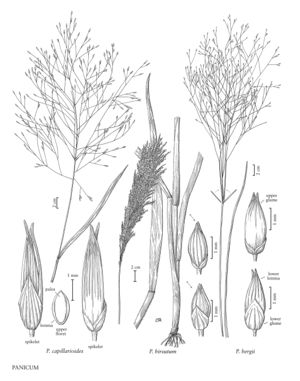Difference between revisions of "Panicum bergii"
FNA>Volume Importer |
FNA>Volume Importer |
(No difference)
| |
Revision as of 19:22, 24 September 2019
Plants perennial; cespitose, with numerous leaves clustered at the base. Culms (10)50-140 cm, stout, stiffly erect, branched from the middle and lower nodes; lower nodes sericeous; lower internodes sericeous, hairs papillose-based, upper internodes sometimes glabrous. Sheaths rounded, glabrous or sparsely to densely hispid, hairs not fragile and prickly, not causing skin irritation, margins ciliate; ligules 1-3 mm; blades 3-60 cm long, 2-12 mm wide, flat or involute, ascending, adaxial surfaces densely hirsute basally, less densely so elsewhere, bases attenuate, apices acute. Panicles (4)15-40 cm long, (3)10-25 cm wide, about 1/3 – 1/2 as long as the plants, open, breaking at the base of the peduncles at maturity and dispersed as tumbleweeds, secondary branching mostly confined to the distal 1/3 of the primary branches; rachises densely hispid or glabrous; lower primary branches in whorls of 4-7, stiffly spreading, naked on the lower 1/2; pedicels 3-20 mm, appressed. Spikelets 2-3 mm long, 0.8-1.2 mm wide, glabrous. Lower glumes 1-1.6 mm, 5-veined, acuminate; upper glumes and lower lemmas similar, 2-2.8 mm, 7-9-veined, exceeding the upper florets by about 0.3 mm; lower florets sterile; lower paleas 1.4-2.2 mm; upper florets 1.5-1.9 mm long, 0.7-1 mm wide, smooth, chestnut brown at maturity. 2n = 36.
Distribution
Tex., Ala., Ga., La.
Discussion
Panicum bergii is an eastern South American species that now grows in southeastern Texas. It occurs in ditches and shallow, and sporadically flooded depressions in grasslands.
Selected References
None.
